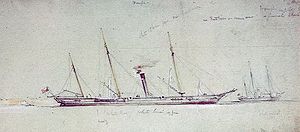 HMS Beagle and Wrangler by
Sir Oswald Brierly, 1855
| |
| History | |
|---|---|
| Name | Beagle |
| Ordered | 10 April 1854 |
| Builder | C J Mare & Company, Leamouth, London |
| Cost |
|
| Laid down | 15 April 1854 |
| Launched | 20 July 1854 |
| Commissioned | 3 September 1854 [1] |
| Fate | Sold to the Satsuma Domain in 1863 |
| Name | Kenko (乾行) |
| Acquired | 1863 |
| Fate | Broken up in 1889 |
| General characteristics [1] | |
| Class and type | Arrow-class gunvessel |
| Displacement | 586 tons |
| Tons burthen | 476 68⁄94 bm |
| Length | 160 ft (48.8 m) |
| Beam | 25 ft (7.6 m) |
| Draught | 11 ft 8 in (3.6 m) (aft) |
| Depth of hold | 13 ft 3 in (4.0 m) |
| Installed power | 160 nhp |
| Propulsion |
|
| Sail plan | Barque-rigged |
| Complement | 65 |
| Armament |
|
HMS Beagle was a wooden-hulled Arrow-class second-class screw gunvessel launched in 1854 and sold in 1863. She was the third vessel of the Royal Navy to use the name.
Design
The Crimean War sparked a sudden need for shallow-draught, manoeuvrable vessels for inshore work in the Baltic and the Black Sea. The Arrow class of six wooden-hulled screw steamers were built during 1854 to a design by the Surveyor's Department. Construction was undertaken at two commercial yards on the Thames, R & H Green and C J Mare & Company, both of Leamouth, London. [1] Two further designs of Crimean War gunvessel were ordered during 1855, the Intrepid class and the Vigilant class. The class was built as despatch vessels, but in 1856 were re-designated as second-class gunvessels.
Propulsion
A two-cylinder horizontal single expansion steam engine supplied by Humphrys, Tennant and Dykes provided 160 horsepower (119 kW) through a single screw. [1]
Sail plan
All Arrow-class gunvessels were barque-rigged. [1]
Armament
The Arrow class were provided with two 68-pounder Lancaster muzzle-loading rifled guns weighing 95 long cwt (4,800 kg) on pivot mounts, and four 32-pounder 25 long cwt (1,300 kg) guns.
Construction and career
Beagle was laid down at the Leamouth yard of C J Mare & Company on 15 April 1854 and launched on 20 July the same year. She was commissioned into the Royal Navy two months later on 3 September. [1]
Beagle took part in the Crimean War from 1854 to 1856. During the Crimean War, two of her ship's company were awarded the Victoria Cross (VC) for their actions: Joseph Trewavas was awarded the VC for his actions in the Sea of Azov, and an acting-mate in Beagle, William Hewett, was awarded the VC for his actions in defending a shore battery. [2]
Beagle was sold to the Satsuma Domain (薩摩藩) of Japan at Hong Kong in 1863 to be used as a training vessel, and was renamed Kenko (乾行) in 1865. She was broken up in 1889. [3]
References
- ^ a b c d e f g h Winfield (2004), p.219
- ^ "No. 21971". The London Gazette. 24 February 1857. p. 652.
- ^ "How the ship, HMS Beagle, got her name". AboutDarwin. Archived from the original on 22 March 2012. Retrieved 25 June 2008.
Bibliography
- Jentschura, Hansgeorg; Jung, Dieter & Mickel, Peter (1977). Warships of the Imperial Japanese Navy, 1869–1945. Annapolis, Maryland: United States Naval Institute. ISBN 0-87021-893-X.
- Lengerer, Hans (2020). "The Kanghwa Affair and Treaty: A Contribution to the Pre-History of the Chinese–Japanese War of 1894–1895". Warship International. LVII (2). International Naval Research Organization: 110–131. ISSN 0043-0374.
- Winfield, R.; Lyon, D. (2004). The Sail and Steam Navy List: All the Ships of the Royal Navy 1815–1889. London: Chatham Publishing. ISBN 978-1-86176-032-6. OCLC 52620555.